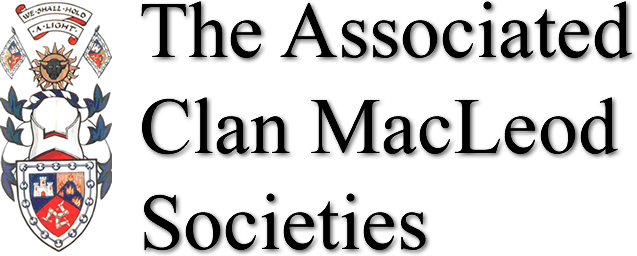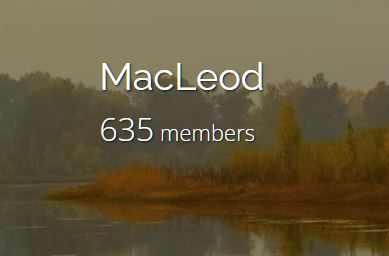A Beginner’s Guide to Y-DNA testing
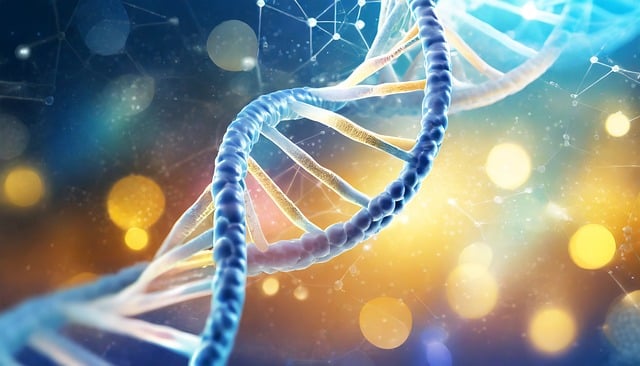
By Al McLeod and Mark MacLeod
The amazing story of adaptation and survival in our species, Homo sapiens, is written in the language of our genes, in every cell of our bodies — as well as in the fossil and behavioural evidence.
The species that every living human being on this planet belongs to is Homo sapiens. During a time of dramatic climate change around 300,000 years ago, Homo sapiens evolved in Africa. Like other early humans that were living at this time, they gathered and hunted food, and evolved behaviours which helped them respond to the challenges of survival in unstable environments.
Scientists now estimate that about 60,000 years ago, after tens of thousands of years of evolution, some groups of these first modern humans began to migrate out of Africa. Y-DNA testing allows us to trace the migration paths of these peoples, our distant paternal ancestors, down to the present day. And, with sufficient testing of our ‘close’ MacLeod relatives, we can learn more about our undiscovered family connections and the more recent history of Clan MacLeod. In particular, we have identified the main migration paths of members of Clan MacLeod alive today and through the Y-DNA testing process we have been able to group MacLeods together into broadly connected sub-families to support genealogical research.
DNA testing as an aid to genealogy and family history research has grown steadily over the last 25 years to become a world-wide industry. Every year as the science progresses, the ability of DNA testing to support genealogical research advances to new levels. In this document, we explain the basics of Y-DNA testing to help our MacLeod clan members better understand the process and encourage MacLeods, or their male relatives, to get tested. As increasing numbers of MacLeod men take Y-DNA tests, we will learn more about previously obscured family connections and the history of our clan.
Ancient Migrations
The desire to explore has been with us since the dawn of humanity. The yearning to see what lies over the horizon, or the promise of a better life, has carried groups of people to all corners of the globe. As they drifted apart, each small population acquired its own unique set of mutations that it passed down to future generations. Over time, these small changes grew to give us the rich diversity of ethnicities and races that we see today.
DNA testing allows us to see what mutations different groups have in common and where they differ. This helps anthropologists and geneticists reconstruct a timeline of humankind’s ancient migration routes out of Africa.
We call the distinct groups that followed these early migratory routes ‘haplogroups’ and each haplogroup is defined by its own unique set of mutations (Fig. 1). The MacLeods are a diverse clan and the distant ancestors of the MacLeods travelled along 3 routes shown by arrows pointing to the R1a, R1b, and I1a haplogroup paths.
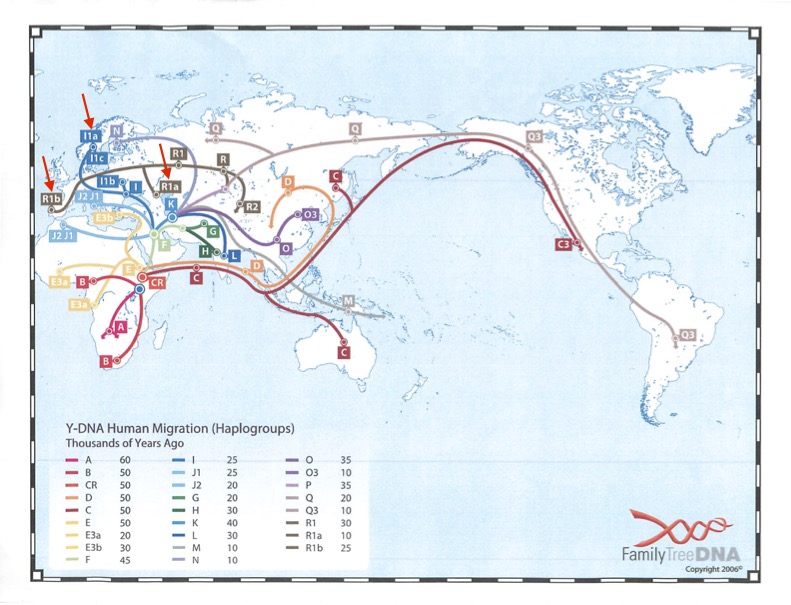
Figure 1. Human migration pathways since the first modern humans left Africa based on Y-DNA analysis. Most MacLeods are descendants of ancestors who travelled either along the R1a, R1b, or I1a paths.
DNA testing and biology basics
DNA contains the blueprint for who we are. Each cell in our body contains 23 pairs of chromosomes or 46 chromosomes in total. We inherit half of each pair from each of our parents. 22 of these 23 pairs are known as autosomal DNA and the final pair contains the sex chromosomes X and Y. Biologically, men have an X and a Y sex chromosome, and women have two X sex chromosomes. Here we are primarily focused on the DNA testing and analysis of just one of these 46 chromosomes, namely the Y sex chromosome found in men.
Each of the 23 pairs of chromosomes is made up of genes. Genes are made up of nucleotides held together in a double helix formation within a chromosome ‘string’ (Fig 2). Our chromosomes are stored within the nucleus of our cells and outside the nucleus are the mitochondria. The mitochondria contain a small section of DNA which is specifically inherited from your mother.
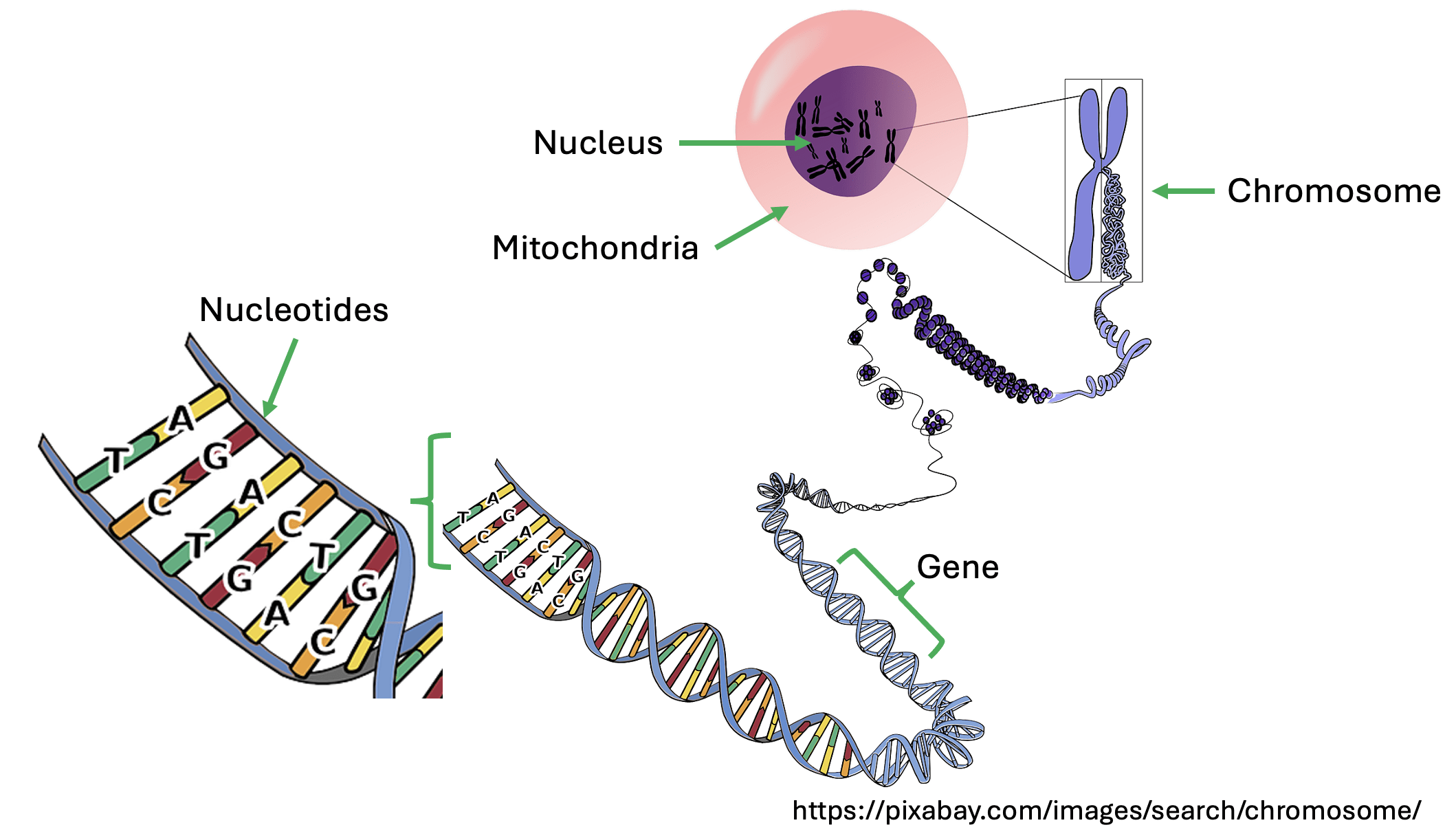
Figure 2. Schematic of a cell containing chromosomes in the nucleus and mitochondria outside the nucleus. The chemicals A, C, G, and T, called nucleotides, align and pair up to build rungs on the ladder of the DNA double helix.
Breaking down the chemistry of the cell further, a nucleotide is made up of 4 chemical components, abbreviated as A, C, G, and T, and these are connected in what are known as base pairs. These base pairs occur in long strings (chromosomes) that are millions of base pairs long.
Genetic genealogy and DNA testing involves creating a detailed map of the chemicals found in a tester’s DNA and then comparing that map to all other testers in the testing company’s database. Similarities between the DNA of two people at specific locations on the various chromosomes may suggest they are somehow related. And from the degree of similarity, we can sometimes infer how closely they are related and how far back in time their common ancestors may have lived. When combined with traditional genealogy using paper records and oral tradition, we can often identify and name these common ancestors with greater confidence.
Why use DNA tests to learn about family history?
Depending on the type of test, DNA testing for genealogical purposes can provide you with three main types of results:
- DNA matches – these are genetic relatives who have also taken a DNA test, share some of your DNA and will share a common ancestor.
- Ethnicity estimates – these provide a percentage estimate of your genetic makeup (e.g., 10% Irish, 60% French, 30% Scottish). While interesting, these estimates are not particularly useful for figuring out your genealogy or connection to the MacLeod clan.
- Ancient origins – this provides a prediction of your deep genetic origins on either your male or female direct line (not available on all tests).
DNA testing has enabled many people to expand their family tree both further back in time and laterally, including distant cousins they were unaware of prior to testing. And with all DNA testing, you must be prepared for surprises – not all assumed relationships hold up under DNA testing!
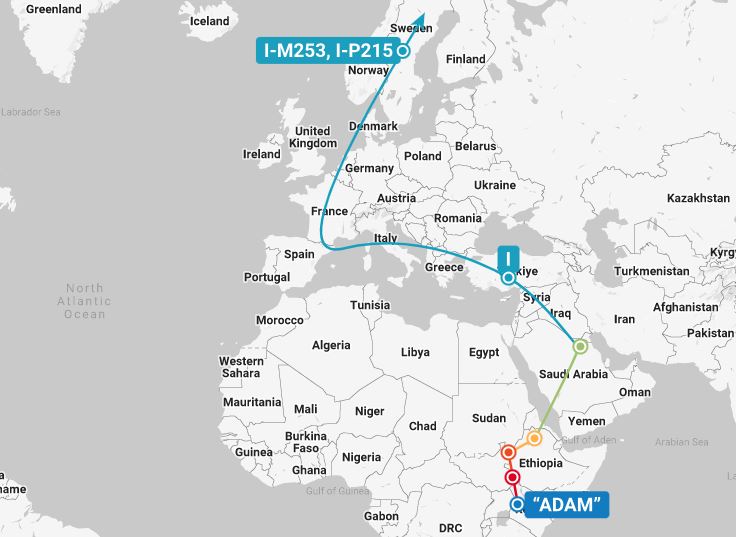
Ancient origins of an I-Haplogroup MacLeod
Types of DNA tests
There are 3 types of DNA tests that are used in genealogical studies:
- Autosomal DNA (atDNA)
- Mitochondrial DNA (mtDNA)
- Y-DNA
While this article focuses on Y-DNA testing, a brief comparison of Y-DNA tests to other test types may be helpful.
Autosomal DNA
Autosomal DNA tests are the most common type of DNA test, and these are available from all the main commercial DNA companies (e.g., Ancestry, MyHeritage, 23andme, FTDNA). This test evaluates 22 of your chromosome pairs but not the 23rd pair which determines a person’s biological sex. Both men and women can take these tests and they are the least expensive of the 3 main test types. Results include DNA matches, ethnicity estimates, and, in some cases, ancient origins. Autosomal testing may well lead to connections with near and distant cousins on both your mother’s and father’s sides of your family.
Half of your autosomal DNA comes from your father and half from your mother. Likewise, half of each of your parent’s DNA came from their parents. However, because of a process called recombination, you will not inherit exactly 25% of each of your grandparent’s DNA. Going further back in time, the amount of DNA inherited from your distant ancestors gets very small and unpredictable, which limits the use of autosomal DNA analysis to looking back beyond perhaps 5-6 generations. These tests are best used to find unknown closer relatives on any of your family lines.
Mitochondrial DNA
Mitochondrial DNA tests evaluate the DNA contained within the mitochondria that surround the nucleus of a cell. It is passed down only from a mother to all her children. Therefore, anyone can take a mtDNA test. However, as mtDNA mutations arise very slowly due to the limited amount of DNA involved, most close relations on your direct maternal line will have identical or very similar mtDNA. This, and the tendency in most western cultures for the mother’s surname to be lost at each generation, limits the utility of mtDNA for family history. However, mitochondrial DNA testing does uncover one’s mtDNA haplogroup, the ancient group of people from whom one’s matrilineage descends.
Y-DNA
Y-DNA tests evaluate the Y chromosome that is only found in men and therefore only men can take these tests. What makes Y-DNA different from other types of DNA is that fathers usually pass an identical copy of their Y chromosome on to their sons, the same way they pass on their surname. The sons in turn pass on a copy of their Y chromosome and surname on to their sons, and so on. There is no mixing, dilution or contribution of DNA from the non-paternal lines. Y-DNA test results include Y-DNA matches, ancient origins, and, in some cases, more recent common ancestors along your patrilineal line.
Fortunately for genealogists and geneticists, there are two main types of harmless mutations (described below) that can occur in the Y chromosome when a son is born, and these mutations are only passed down the paternal line. By evaluating the Y chromosome of MacLeod men, and comparing their respective mutations, we can ultimately connect MacLeod families who may not have known they were related.
A MacLeod who takes a Y-DNA test will learn if he is on any one of the five main genetic branches which make up the MacLeod clan today. If he happens to be on the branch leading to the founder of the clan, he will also learn whether he is on the Harris & Dunvegan branch or the Lewis & Raasay branch of MacLeods. And, if he takes the most advanced Y-DNA test, known as the ‘Big-Y’, he may learn which sub-branch of these two main branches his ancestors came from.

Interpreting your Y-DNA test results
Y-DNA tests are mainly offered by FamilyTreeDNA of Houston, Texas. Over the years, FTDNA has offered a wide variety of testing options. Today, their tests come in two varieties: 1) STR tests, at two levels of precision and cost: a 37-marker test (Y-37) and a 111-marker test (Y-111), and 2) the Big Y test that finds the important ‘SNP’ mutations on the tester’s Y chromosome. The Big Y test also includes STR testing at the highest level of precision available, and it is the most expensive option at around US$450 (on sale these tests cost around US$400). If you are considering a Y-DNA test, please review our guide for DNA testing to determine which test is best for you and do get in touch with us if you are unsure and need advice.
In this section, we explain some of the details and intricacies of interpreting your Y-DNA test results including the acronyms and terms used above. We recognize that interpreting your Y-DNA test results is complicated, and involves many new concepts and some confusing terminology. Patience and a willingness to learn is required, and keep in mind that help is available!
As mentioned earlier, there are two main types of harmless mutations that can occur on the male Y chromosome when a son is born, and it is these mutations that we can use to connect related MacLeods to one another. These mutations are called: 1) Short Tandem Repeats (STRs) which lead to Y-DNA match lists; and 2) Single Nucleotide Polymorphisms (SNPs).
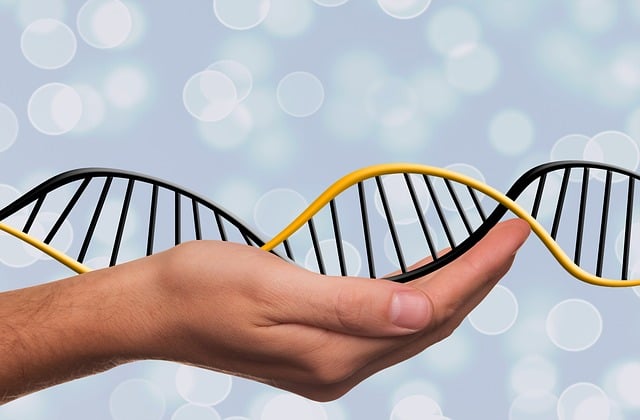
Short Tandem Repeats (STRs) and Y-DNA match lists
Assuming you have taken a Y-DNA test, and your results have arrived, we suggest starting by reviewing your Y-DNA match list at the highest marker level of your test. Your match list shows men whose Y-DNA results are similar to yours (we’ll explain what ‘similar’ means below) and are somehow related along your paternal line. Some MacLeod testers will find that their Y-DNA match list contains many other MacLeods, however spelled, whereas others will find very few or no other MacLeod matches. This is your first clue as to which branch of MacLeods is your branch.
If your highest level of testing is at 37 markers, your match list may contain hundreds of matches but many of these matches will only be very distantly related to you. Most matches below 37 markers (e.g., at 12 or 25 markers) will be very distantly related and probably not worth your time investigating. If you have tested to 111 markers, matches at this level will be more closely related to you than most of your matches at 37 markers.
To create your match list, FTDNA first evaluates markers on your Y chromosome. Markers are specifically chosen sections of Y-DNA that contain repeated patterns of nucleotides called ‘Short Tandem Repeats’ (STRs). For example, ‘CATCATCAT’ is the 3 nucleotides C, A, and T repeated 3 times. The number of repeats is recorded at each marker and those values are compared against a potential match. Each difference in the number of repeats represents a mutation in one man not shared by the other.
If you and another man have the same or a very similar number of repeats at these markers, you are considered a match to this man. The measure of how closely you are related is called your ‘genetic distance’.
The genetic distance is calculated as the sum of the total number of differences at each marker that has been tested by both you and your match. For example, imagine you and your match have the identical number of short tandem repeats over 37 markers except Marker 2, which has a difference of 1 (19 vs. 20), and Marker 11, which has a difference of 2 (35 vs. 33) (Table 1). The genetic distance between you and your match is 3 (1 + 2). Based on this, FTDNA’s ‘Time Predictor’ tool estimates that you and your match share a ‘most recent common ancestor’ (MRCA) who was born circa 1500 CE, though this estimate comes with a wide range of uncertainty. This shows that you are distantly related to this man as your MRCA is at least 15 generations in the past.

Table 1. Schematic listing of Short Tandem Repeat counts for 12 of 37 markers for 2 people. The genetic distance is a measure of relatedness and is calculated as the sum of the differences between the STR counts at each marker. In this case, a genetic distance of 3 shows that these two individuals may share a common ancestor who was born c. 1500 CE.
However, a genetic distance of 3 over 111 markers translates into a much closer match, with an MRCA born c. 1750 CE. A rule of thumb is that a genetic distance of 1 for a Y-37 test is about the same as a genetic distance of 3 for a Y-111 test and both indicate that you share a MRCA with your match who was born c. 1750 CE, or roughly within the past 10 generations.
In summary, a small genetic distance at 111 markers indicates that you share a ‘recent’ common ancestor with your match. For example, a genetic distance of zero means that there have been no mutations of the 111 Y-DNA markers between you and your match and you are likely to be very closely related. Note, however, that even a father and son could have a non-zero genetic distance as an STR mutation can occur in any offspring (Fig. 3).

Figure 3. Y-DNA match between Al McLeod, President of ACMS, and his son Peter Alexander McLeod showing a genetic distance of 1 over 111 markers. Al’s second closest match at a genetic distance of 2 is with Victor John McLeod III with whom he may share a most recent common ancestor (MRCA) about 7 generations back.
One weakness of STR analysis is that the number of repeats will mutate at highly variable rates for each marker, and they can even mutate back to the original value. Therefore, FTDNA’s estimated time to the most recent common ancestor (MRCA) typically has a wide range of uncertainty.
Despite these weaknesses, FTDNA compares the STR values for an individual with their entire database and either predicts or confirms a haplogroup for anyone who takes a Y-DNA test. If a man took a Y-37 or Y-111 test, FTDNA commonly provides a haplogroup that is ‘high-level’, dating back to before the common era (CE, which is numerically equivalent to ‘AD’). For example, many members of the MacLeod surname project who have tested at lower marker levels have been assigned the R-M269 haplogroup, representing a man born c. 4350 BCE somewhere along the R1b path in Figure 1, which is not particularly useful or informative.
The surnames on your Y-DNA match list are also important. If more than a dozen of your matches at 111 markers carry the MacLeod surname, however spelled, it’s likely that you descend from the founder of the clan. Also, you should take note of the ‘Y Haplogroup’ and ‘Paternal Country of Origin’ of your matches, as your haplogroup and origin may be the same or similar
Y-DNA SNPs
The second type of mutation on the Y chromosome is called Single Nucleotide Polymorphism or SNP (pronounced ‘snip’). Over the last 5 years, the Big Y test and the SNPs that are found using this test have become the gold standard for Y-DNA analysis and genetic genealogy.
As noted earlier, a DNA molecule is made up of four chemicals adenine (A), cytosine (C), guanine (G), and thymine (T). The DNA molecule consists of two strands wound around each other, with one of these chemicals on one strand pairing with its complementary chemical on the other strand. Sometimes when a son is conceived a small copy error, like a spelling mistake, occurs where one chemical is substituted for another on the DNA strand. For example, a C, that is always paired with G, can be copied as a T, which is always paired with A (Fig 4). When this occurs on a single nucleotide we call it a SNP.

Figure 4. Schematic of a ‘SNP’ mutation on the Y chromosome. Here, the base pair C and G is replaced with the base pair T and A. Any son born with this mutation will pass it on to his male descendants. If two or more men are found to have this mutation, the mutation is given a name, and it creates a new branch (haplogroup) on the tree of humankind. (https://texasmacleods.wordpress.com/dna/)
These types of mutations are infrequent, and many generations can pass without a SNP occurring. Approximately every 3rd or 4th generation, a son is born with a SNP that makes him unique and slightly different from his father. He will then pass on this mutation to all his male descendants. With this new mutation, this son has started a new branch on the tree of humankind. Men born today have accumulated thousands of Y-chromosome mutations that have occurred over the millennia along their specific paternal branch (Fig. 5).
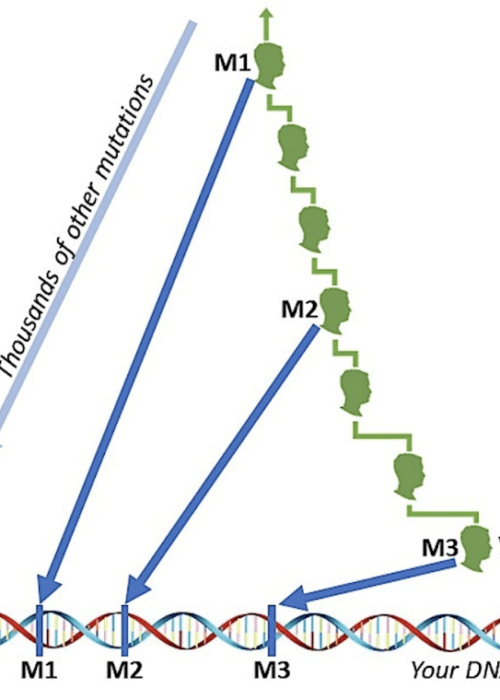
Figure 5. Mutations (including M1, M2) from all your paternal-line ancestors have accumulated in your DNA, along with your own mutation (M3). [Dave Vance, 2020].
This pattern of inheritance of both surname and the Y chromosome, along with all the accumulated mutations, is what makes Y-DNA SNP testing so powerful. Geneticists are now able to determine the chronological order and approximately when each of these mutations appeared on the tree of humankind. And they can roughly estimate where the son first born with a new mutation once lived. Taken together, Y-DNA analysis allows us to map the timeline and path our ancestors took from Africa to the birthplace in Scotland of our earliest known MacLeod ancestors.
For example, the estimated migration path taken by the paternal ancestors of a man born with a mutation with the name ‘R-BY3210’ ends in Scotland (Fig. 6). This mutation is on a sub-branch of the R1b haplogroup shown in Figure 1 and it is found today on the Y chromosome of many MacLeods. Note that each dot on this map is labelled with the name of a different earlier mutation that will be found in this man’s Y chromosome (and that of many MacLeods). The position and colour of the dot represents the approximate birth location and time-period for the man first born with the labelled mutation. These dots also represent points in time and place where other sons of this man branched off and headed in different directions.
As the map shows, this ‘R-BY3210’ man is believed to have been born in Scotland in the Medieval era (orange dot). The more precise estimate is that R-BY3210 was born around the year 900 CE, well before surnames in Europe. Like all humans alive today, the map shows the man’s earliest origins were in Africa in the Paleolithic Period (2.5 million years ago to 10,000 BCE). By the end of the Neolithic Period (blue dots, 10,000 BCE – 2000 BCE), this man’s distant paternal ancestors are living in what is now France. There is an information gap during the Bronze Age shown by the lack of a light blue dot but by the Iron Age (green dot), R-BY3210’s ancestors had arrived in Scotland. You can think of these displays as showing how the distant paternal ancestors of R-BY3210 have left a trail of breadcrumbs along their very long march from Africa to Scotland.
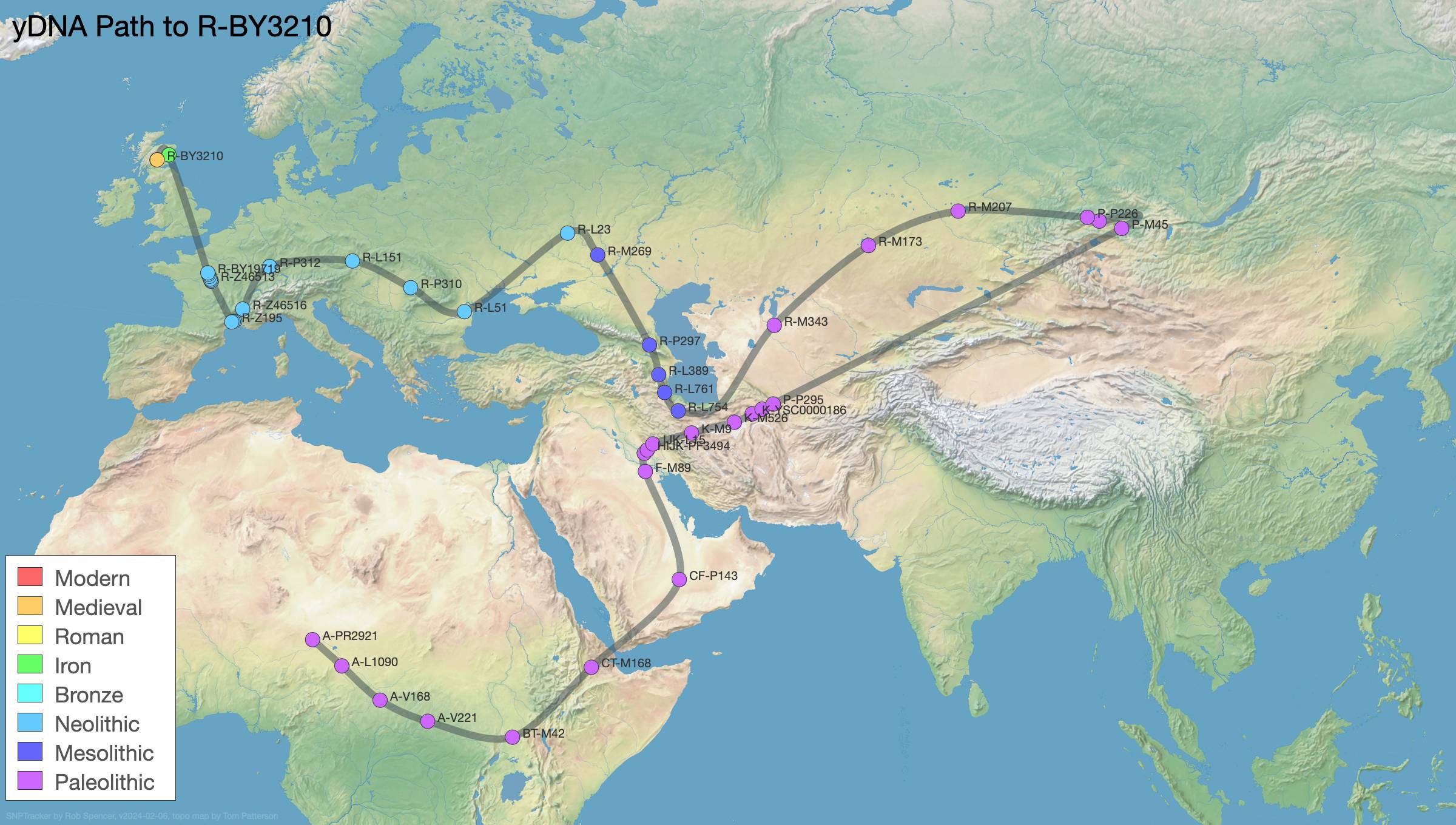
Figure 6. Possible migration pathway of the distant paternal ancestors of a man born in Scotland with the mutation named R-BY3210. This mutation is often found in MacLeod men and it has been linked to the founder of the Clan. (From the SNP Tracker tool at www.scaledinnovation.com.)
In another example, the migration path for another man born in Scotland around 1600 CE with a mutation named I-FT381308 is very different (Fig 7). This mutation is on a sub-branch off the I1a haplogroup path shown in Figure 1. Currently, we know of eight MacLeods who carry this mutation on their Y chromosome. By comparing the two maps, note that the migration paths are identical coming out of Africa but then the two paths split, branch off and move in nearly opposite directions during the Palaeolithic period in what today is Iraq. Later, in the Bronze Age, the ancestors of I-FT381308 were in Scandinavian countries.
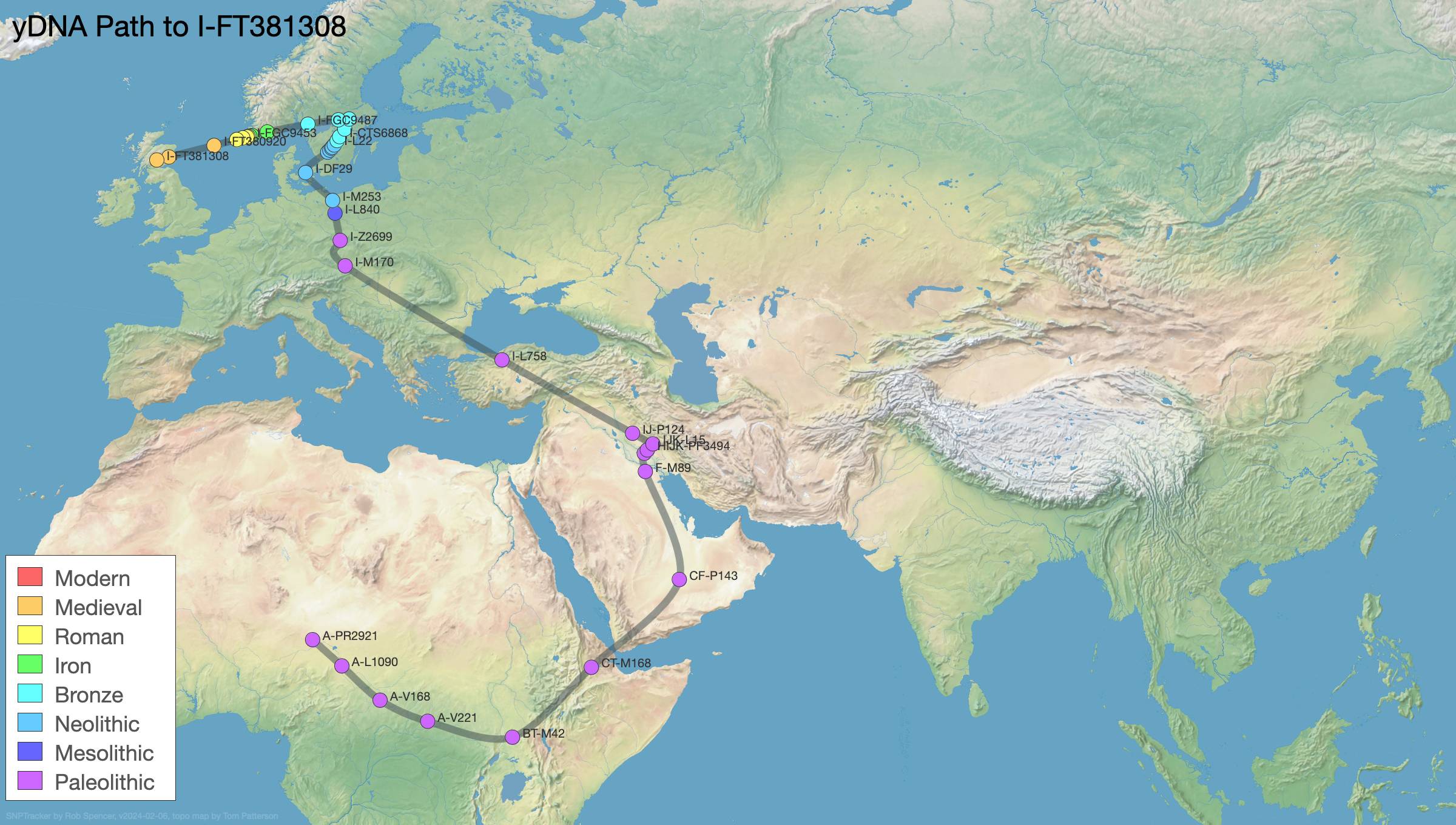
Figure 7. Possible migration pathway of the distant paternal ancestors of a man born in Scotland with the mutation named I-FT381308. So far, this mutation has been found in 8 MacLeod men. (From the SNP Tracker tool at www.scaledinnovation.com.)
If two men take a Y-DNA test today and one man has the R-BY3210 mutation on his Y chromosome and the other has the I-FT381308 mutation, we can say their most recent common paternal ancestor was a man born in the Paleolithic time-period in the Near East. While their recent paternal ancestors both lived in Scotland and were part of Clan MacLeod, their distant ancestors arrived there along very different paths!
Geneticists have currently identified about 80,000 unique Y-chromosome mutations (SNPs), and from this they have built a giant family tree of humankind. MacLeods who have taken Y-DNA tests can be found on this tree in several places. As more MacLeods take Y-DNA tests, these places on the tree will be further developed and enhanced, allowing us to more clearly picture our shared MacLeod history and genealogy.
FTDNA’s Block Tree
One output of a FTDNA’s Big Y test is called the Block Tree (Fig 8). These are like family trees but instead of names, the tester’s ancestors are listed by the names of the SNPs that the tester shares with other testers. Separately, FTDNA provides an estimate of the mean birth year and estimated range for each SNP. These age estimates are derived by FTDNA using a proprietary algorithm which combines both STR and SNP results and is considered more accurate than STR-based age estimates. In some cases, testers can combine the Block Tree with known or speculative genealogical work to assign real names to SNPs.
For example, part of the Block Tree for Mark MacLeod, co-author and an administrator of the MacLeod surname project, shows that he shares a SNP named R-FT245606 with his close relative Jim A. MacLeod (Fig. 8). FTDNA’s mean estimated birth year of this SNP is 1879 CE, which closely matches the birth year of their MRCA, Ernest James MacLeod, b. 1876. The next older SNP is R-FT246597, with a mean estimated birth year of 1736 CE. This SNP is shared with two other testers, namely Neil Charles McLeod and Ross C. McLeod. We know from paper records that the MRCA for all 4 men is Norman MacLeod, born around 1785, on the Isle of Raasay. So, R-FT246597 could be Norman or Norman’s father given the +/- 100-year range of uncertainty. The next oldest SNP is R-FT371272, born around 1355, which is shared with 16 other MacLeods not shown here. Based on the genealogy of several of these MacLeods, R-FT371272 could be Tormod Mòr MacLeod (‘Old Norman’) of Uig, Lewis, great grandson of Torquil Òg, the 1st chief of the MacLeods of Lewis, who is thought to represent R-FT6192. As Torquil Òg is a great grandson of Leòd, by using Y-DNA testing we have established a possible direct paternal line connection back to the progenitor of the MacLeod clan.
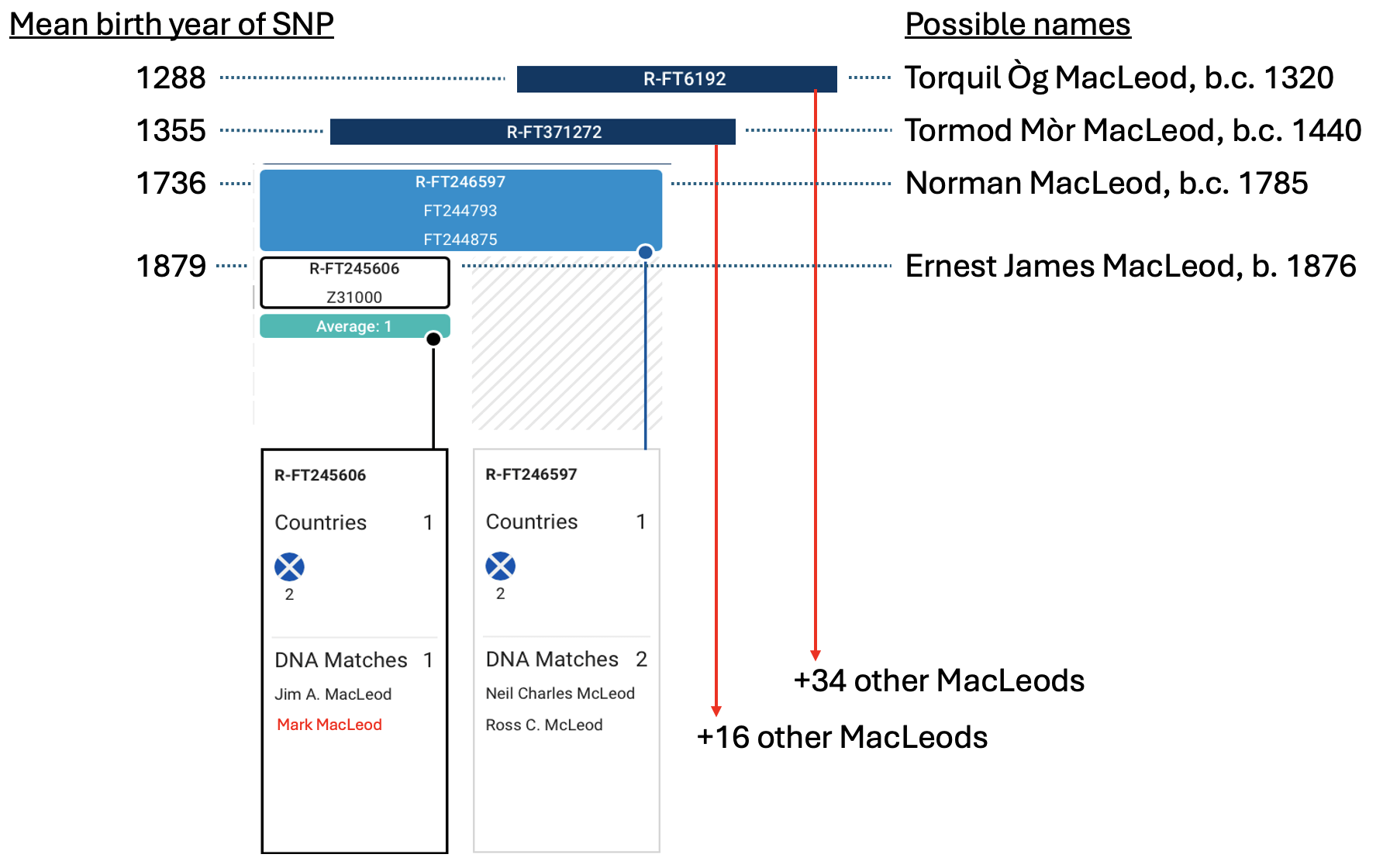
Figure 8. Partial Block Tree display for Mark MacLeod showing how he and Jim A. MacLeod descend from R-FT245606, who descends from R-FT246597, who descends from R-FT371272, who descends from R-FT6192, who is believed to be Torquil Òg MacLeod, 1st chief of the MacLeods of Lewis, great grandson of Leòd. In total, 54 tested MacLeods in our MacLeod DNA project are believed to be descendants of Torquil Òg on four main sub-branches.
Y-DNA testing and the MacLeod surname project
In 2004, the Associated Clan MacLeod Societies established a MacLeod surname project at FTDNA as a place where MacLeods could share their Y-DNA results, and project administrators could review, organize, and help MacLeods interpret their results. If you need help understanding your Y-DNA results, we suggest joining the MacLeod surname project at FTDNA and asking the administrators for support.
The MacLeod surname project currently has 635 members, and most have taken some level of Y-DNA test. From these tests, Y-DNA shows us that most MacLeod men can be placed in one of five genetically distinct groups. The MacLeod men in the largest of these groups carry the R-BY3210 SNP and are likely direct paternal line descendants of Leòd, the founder of the clan, as shown in this video presented at the 2023 MacLeod Clan Parliament. The other four groups are likely descendants of men who assumed the MacLeod surname far back in time. These men have distant ancestors that were likely either Vikings who came from Scandinavian countries or part of Celtic cultures who came to Scotland from Ireland and England.
Autosomal DNA tests show that most MacLeod men in these five groups will likely have a female MacLeod somewhere in their family tree who is a direct descendant of Leòd. Therefore, most MacLeods, women and men, are likely have a link back to Leòd, either along their paternal line or through a maternal connection, or both.
The STR results and haplogroup designations of all the Y-DNA tested MacLeods can be seen here: https://www.familytreedna.com/public/ACMS_MacLeod?iframe=ycolorized
In closing …
In closing, we hope we have clarified some aspects of Y-DNA testing and perhaps this article has encouraged you or a male MacLeod relative to take a Y-DNA test. Not only will you learn about your own paternal-line ancestors, but you will be assisting Clan MacLeod in advancing our understanding of this important part of our Clan’s history. And please don’t be put off by the complexity of Y-DNA testing – administrators of the MacLeod Surname Project and others are always available to help.
Acknowledgements and references
Amelia (Mia) Bennett at https://www.miagenealogy.com/
The Associated Clan MacLeod Societies, https://www.clanmacleod.org/genealogy/dna-project/
Clan MacLeod Texas, https://texasmacleods.wordpress.com/dna/
Dave Vance, 2020, The Genealogist’s Guide to Y-DNA Testing for Genetic Genealogy. Available on Kindle.
The Help Centre at FamilyTreeDNA
Tracking Back, http://scaledinnovation.com/, SNP Tracker tool
Y-DNA Genealogy Made Easy at https://p-rr-tt.org.uk/Y-DNA/DNA.html
With thanks to the entire Clan MacLeod Y-DNA Surname Project administrator team (Rod MacLeod & Colin Macleod, alongside Mark MacLeod) for contributions to this article, and to David MacLeod for support with proof reading.
